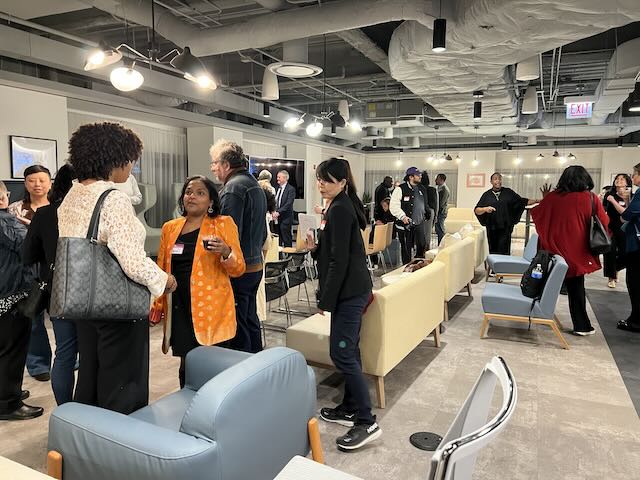The majority of journalists who were laid off or took buyouts since 2022 were early in their career or in their positions for three years or less, a new report found.
The majority were women (68%) and journalists of color (42%), according to the results of a survey from the Institute for Independent Journalists that was funded by the Field Foundation of Illinois.

Journalists of color were disproportionately impacted considering they represent only 17% of the news industry.
The survey data was the subject of a panel discussion on Nov. 19 in Chicago called “Journalism Job Crisis: A Call to Action.” The event was organized by Maudlyne Ihejirika, a Chicago Sun-Times columnist for 30 years and the Field Foundation of Illinois’ current program officer of journalism and storytelling.
The need for this survey was born from the fact that there is little demographic data shared with the public about the people impacted by these layoffs or buyouts. “This is ongoing and there has never been a more important time to have this conversation.” Ihejirika said. “We’ve got to find out who’s being laid off because it’s not tracked anymore.”
The Institute for Independent Journalists surveyed 176 journalists who were laid off or took a buyout from 2022 until mid-September of this year.
Challenger, Grey & Christmas reported that there have been 8,300 journalists laid off within the last three years. The IIJ’s survey highlights three major areas of demographic information: layoffs by race, gender and by years in job.
One of the survey’s most noteworthy findings was that the majority of those getting laid off were in their jobs for three years or less. This means that the majority of journalists getting laid off started in their positions in or around 2020, which was, needless to say, a momentous year in the media industry. One of the most repeated phrases of the evening was that this pool of new journalists experiencing layoffs are “tomorrow’s leaders,” which underscored a concern over many newsroom’s commitment to their future commanders. Journalists laid off after being in their jobs for 10 years or less made up a staggering total of 87% of survey findings.
Tim Franklin, senior associate dean of the Medill School of Journalism at Northwestern University, led the team that published Medill’s third annual State of Local News report last month. He said the journalism industry has lost 70% of its journalists in the last 20 years, which is the fourth highest industry loss, behind the likes of the textile industry and CD and cassette industries.
Franklin, one of the panelists at the event, also said that Illinois itself has lost 86% of its newspaper journalists in the last two decades, and Cook County, in particular, led the nation in journalism job loss in 2018. Roughly two and a half newspapers are closing in the U.S. weekly, according to Franklin.
Several panelists emphasized the need for the public, as well as journalists themselves, to hold newsrooms and media companies accountable in the same ways that many hold other industries. Meredith D. Clark, associate professor at the University of North Carolina at Chapel Hill, said that this current moment in politics, with Donald Trump elected back into office, “proves advantageous” for newsrooms to reshape their coverage of corrupt politicians and broken political systems, because the way it has been done in the past “has reached its full life cycle.”
Insights derived from the demographic data illustrate the increased instability of the industry that has deterred people away from journalism altogether.
Katherine Reynolds Lewis, founder of the Institute for Independent Journalists, shared that one of the survey respondents experienced two layoffs in one year and had to start from square one again shortly after landing a new job post-layoff.
Clark delivered what Deborah D. Douglas, the director of Medill’s Midwest Solutions Journalism Hub, coined the “mic drop” moment of the evening, saying that newsrooms must face their history of being largely white, patriarchal structures that aren’t adaptable to today’s news ecosystem. “White supremacy, and the systems that are built out of it, including capitalism, don’t factor for a down cycle,” she said. “If you are not producing at a high enough level, then you find another way to exploit a different group in order to increase your profits.”
The trend among newsrooms to produce content at rapid speeds with smaller amounts of staff to do the work creates a supply and demand problem, Edes said. The result of which increases pressure on individual journalists and increases workloads, which threatens to create an unhealthy environment that can lead to what Edes called “clinical burnout.”
Early in the evening Douglas said that “journalism is not where you work, it’s who you are.”
Near the end of the panel’s discussion, Alyssa Edes, a Chicago-based producer and former employee at WYNC, countered Douglas’ sentiment and emphasized the need for a restructuring of not only the way newsrooms operate, but journalist’s relationship to their work, which the other panelists echoed.
“Journalists are knowledge workers,” Reynolds Lewis said. They can “have long careers if we take care of our bodies and our minds and our hearts. This false urgency of ‘[I] have to get the story today,’ is what we need to turn away from, and instead think about long term, ‘What do I want my impact to be?’”
Avery Heeringa is a Chicago-based freelance journalist with a specialty in arts and culture reporting. He has written for the Chicago Reader, Melodic Magazine and Off the Record Press, among others.
- Institutions of journalism accountability disappear
- Episode 2: When a university tries to stop the press
- When Teen Vogue’s newsroom went silent, so did a generation’s voice.
- Pulitzer value of independence infuses 50 year journey from rookie reporter, to globe-trotting correspondent to founder of nation’s leading news nonprofit
- As AI in journalism takes root, safeguards and training are needed. Treat AI like an enthusiastic intern who has to be checked

